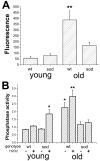Paradoxical actions of hydrogen peroxide on long-term potentiation in transgenic superoxide dismutase-1 mice
- PMID: 14614095
- PMCID: PMC6741007
- DOI: 10.1523/JNEUROSCI.23-32-10359.2003
Paradoxical actions of hydrogen peroxide on long-term potentiation in transgenic superoxide dismutase-1 mice
Abstract
Hydrogen peroxide (H2O2), a reactive oxygen species, is assumed to have a detrimental effect on neuronal plasticity. Indeed, H2O2 suppresses long-term potentiation (LTP) in hippocampal slices of normal rats and wild-type (wt) mice. Transgenic mice overexpressing superoxide dismutase (SOD) 1 (tg-SOD), which maintain high ambient H2O2, have also been shown to be impaired in their ability to express hippocampal LTP. Paradoxically, H2O2, at a concentration (50 microm) that blocks LTP in wt mice, actually enhanced LTP in slices of 2-month-old tg-SOD mice. H2O2-dependent LTP in tg-SOD was blocked by the protein phosphatase calcineurin inhibitor FK506, but not by rapamycin, an FK-binding protein 12 (FKBP12) inhibitor or by 1-(5-isoquinolinesulfonyl)-2-methylpiperazine (H7), a serine-kinase inhibitor. Interestingly, wt and tg-SOD mice expressed similar levels of the antioxidant enzyme catalase and similar activity of glutathione peroxidase. An opposite situation was found in 2-year-old mice. Aged wt mice were impaired in LTP in a manner that could be reversed by the addition of H2O2. Surprisingly, aged tg-SOD mice exhibited larger LTP than that found in wt mice, but this was now reduced by 50 microm H2O2. Both young tg-SOD and aged control mice displayed altered protein phosphatase activity, compared with that of young controls; moreover, FK506 inhibited LTP in old tg-SOD as well as in old wt mice treated with H2O2. These data promoted a dual role for H2O2 in the regulation of LTP, and proposed that it is mediated by the protein phosphatase calcineurin.
Figures









Similar articles
-
Amyloid β-induced impairments in hippocampal synaptic plasticity are rescued by decreasing mitochondrial superoxide.J Neurosci. 2011 Apr 13;31(15):5589-95. doi: 10.1523/JNEUROSCI.6566-10.2011. J Neurosci. 2011. PMID: 21490199 Free PMC article.
-
Peroxide modulation of slow onset potentiation in rat hippocampus.J Neurosci. 1997 Nov 15;17(22):8695-701. doi: 10.1523/JNEUROSCI.17-22-08695.1997. J Neurosci. 1997. PMID: 9348338 Free PMC article.
-
Upregulation of GABA neurotransmission suppresses hippocampal excitability and prevents long-term potentiation in transgenic superoxide dismutase-overexpressing mice.J Neurosci. 1999 Dec 15;19(24):10977-84. doi: 10.1523/JNEUROSCI.19-24-10977.1999. J Neurosci. 1999. PMID: 10594078 Free PMC article.
-
Age-dependent modulation of hippocampal long-term potentiation by antioxidant enzymes.J Neurosci Res. 2006 Nov 15;84(7):1564-74. doi: 10.1002/jnr.21040. J Neurosci Res. 2006. PMID: 16941635
-
Role of reactive oxygen species in hippocampal long-term potentiation: contributory or inhibitory?J Neurosci Res. 2002 Oct 1;70(1):1-7. doi: 10.1002/jnr.10371. J Neurosci Res. 2002. PMID: 12237859 Review.
Cited by
-
Influence of viral vector-mediated delivery of superoxide dismutase and catalase to the hippocampus on spatial learning and memory during aging.Antioxid Redox Signal. 2012 Feb 15;16(4):339-50. doi: 10.1089/ars.2011.4054. Epub 2011 Dec 1. Antioxid Redox Signal. 2012. PMID: 21942371 Free PMC article.
-
Cross talk between Ca2+ and redox signalling cascades in muscle and neurons through the combined activation of ryanodine receptors/Ca2+ release channels.Philos Trans R Soc Lond B Biol Sci. 2005 Dec 29;360(1464):2237-46. doi: 10.1098/rstb.2005.1759. Philos Trans R Soc Lond B Biol Sci. 2005. PMID: 16321793 Free PMC article. Review.
-
Hydrogen peroxide as a diffusible signal molecule in synaptic plasticity.Mol Neurobiol. 2004 Apr;29(2):167-78. doi: 10.1385/MN:29:2:167. Mol Neurobiol. 2004. PMID: 15126684 Review.
-
Optical and pharmacological tools to investigate the role of mitochondria during oxidative stress and neurodegeneration.Prog Neurobiol. 2006 Jun;79(3):136-71. doi: 10.1016/j.pneurobio.2006.07.001. Prog Neurobiol. 2006. PMID: 16920246 Free PMC article. Review.
-
Amyloid β: linking synaptic plasticity failure to memory disruption in Alzheimer's disease.J Neurochem. 2012 Jan;120 Suppl 1(Suppl 1):140-148. doi: 10.1111/j.1471-4159.2011.07506.x. Epub 2011 Nov 28. J Neurochem. 2012. PMID: 22122128 Free PMC article. Review.
References
-
- Anderson WW, Collingridge GL ( 2001) The LTP Program: a data acquisition program for on-line analysis of long-term potentiation and other synaptic events. J Neurosci Methods 108: 71-83. - PubMed
-
- Bear MF, Abraham WC ( 1996) Long-term depression in hippocampus. Annu Rev Neurosci 19: 437-462. - PubMed
-
- Beckman KB, Ames BN ( 1998) The free radical theory of aging matures. Physiol Rev 78: 547-581. - PubMed
-
- Bogumil R, Namgaladze D, Schaarschmidt D, Schmachtel T, Hellstern S, Mutzel R, Ullrich V ( 2000) Inactivation of calcineurin by hydrogen peroxide and phenylarsine oxide: evidence for a dithiol-disulfide equilibrium and implications for redox regulation. Eur J Biochem 267: 1407-1415. - PubMed
-
- Cathcart R, Schwiers E, Ames BN ( 1983) Detection of picomole levels of hydroperoxides using a fluorescent dichlorofluorescein assay. Anal Biochem 134: 111-116. - PubMed
Publication types
MeSH terms
Substances
LinkOut - more resources
Full Text Sources
Molecular Biology Databases
Miscellaneous
